|
|
Post by shartmeyer on Sept 4, 2010 9:51:39 GMT
Really nice plants, thanks for the pictures. However, not only the Japanese know how to grow Byblis. Here is a photo of our Byblis cultivar Goliath, grown from seeds received from Brian Barnes. The set of plants shows about 100 flowers at the moment. They look exactly like the B. guehoi, however, until now only Goliath, but not the B. guehoi (grown from seeds from the CPUK) produce seeds (2nd picture). To harvest pollen for pollination I use an electrical tooth brush tip, and that "tooth brush sex" is easy to handle for buzz-pollination and very successful. 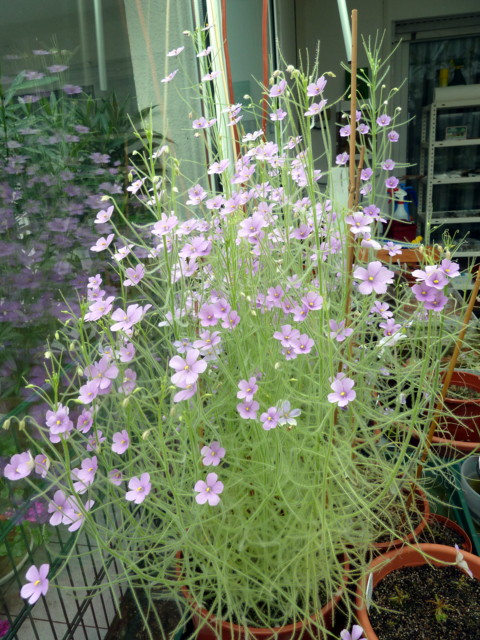 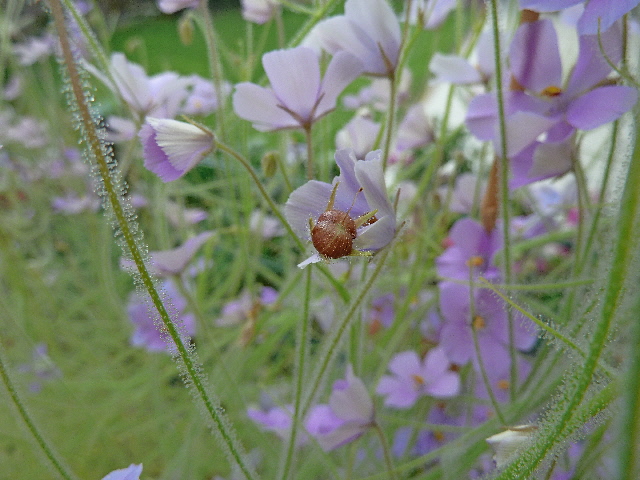 |
|
sweetpea
Full Member
MOLLIE RILSTONE
Posts: 163
|
Post by sweetpea on Sept 4, 2010 13:00:25 GMT
Konnichiwa! Really nice plant!!!  Both of you and jonmoyjunk-san's results must stimulate European cp growers! GREAT!!!  Unfortunately, from your photo, I can not judge your plant is a progeny clone of Byblis filifolia ICPS cultivar 'Goliath'. In my cultivation, Byblis guehoi is very different from other tropical Byblis species. Did you touch glandular mucus of Byblis guehoi (compare it with that of your progeny clone of Byblis filifolia ICPS cultivar 'Goliath'  ) Please see photo 1: In my cultivation, almost ALL tropical Byblis species branch(at this moment: all). In my cultivation, Byblis guehoi branches at a much earlier stage than other tropical Byblis species. Same as jonmoyjunk-san's plant. In my cultivation, the progeny clones of Byblis filifolia ICPS cultivar 'Goliath' NEVER branch at an early stage. Please post a much clear photo: compare Byblis guehoi plant with your progeny clone of Byblis filifolia ICPS cultivar 'Goliath' in your cultivation( in the same environment). Dear jonmoyjunk-san, please post your photo if you have: compare your Byblis guehoi plant with your progeny clones of Byblis filifolia ICPS cultivar 'Goliath' in your cultivation ( in the same environment). photo1: Comparative photo: branching habit of the progeny clone of Byblis filifolia ICPS cultivar 'Goliath' and Byblis guehoi in my cultivation I took the photo just now. photo2,3,4,5: the progeny clones of Byblis filifolia ICPS cultivar'Goliath' I took the photos last year Kind regards 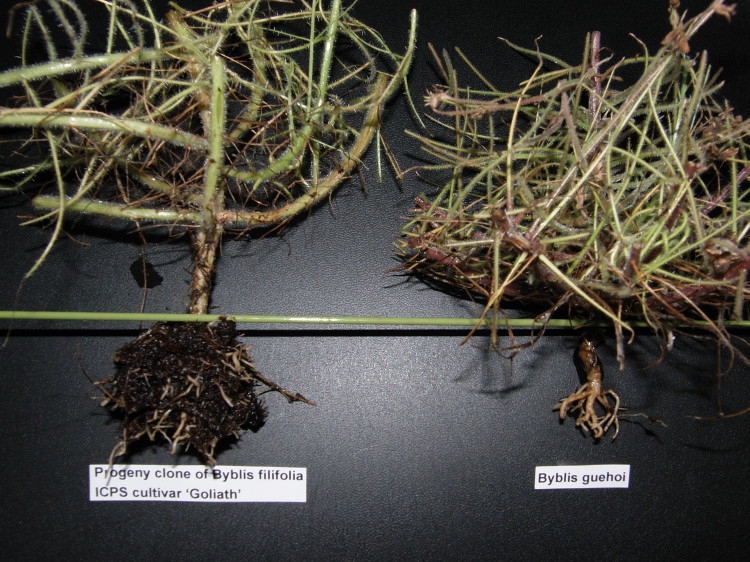 photo 1 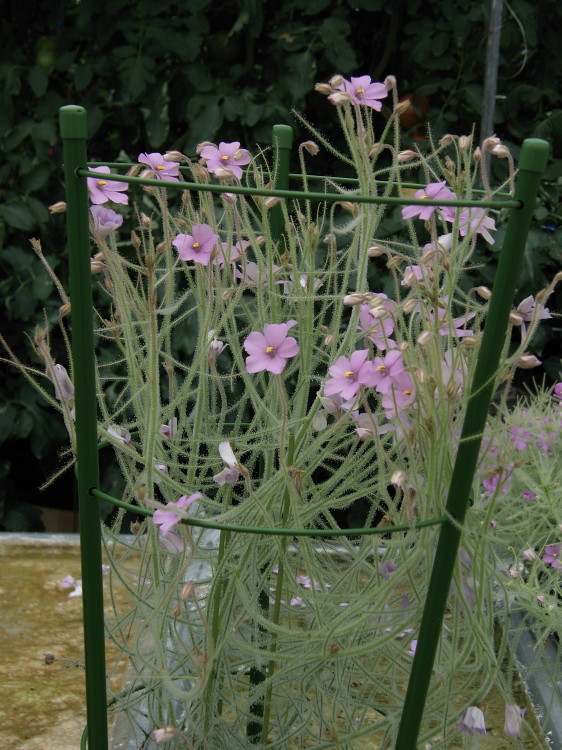 photo 2 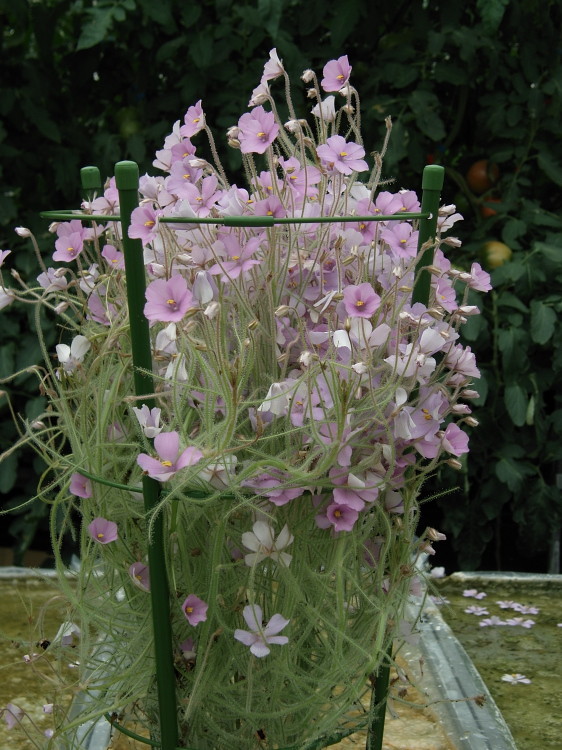 photo 3 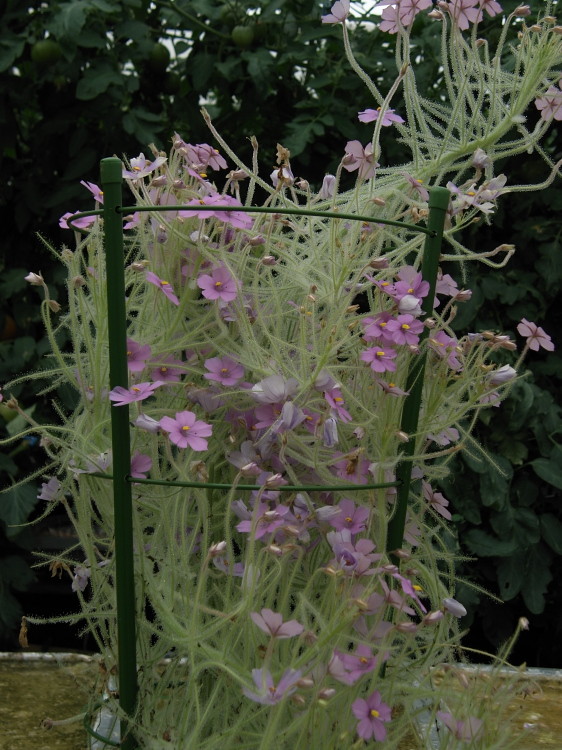 photo 4 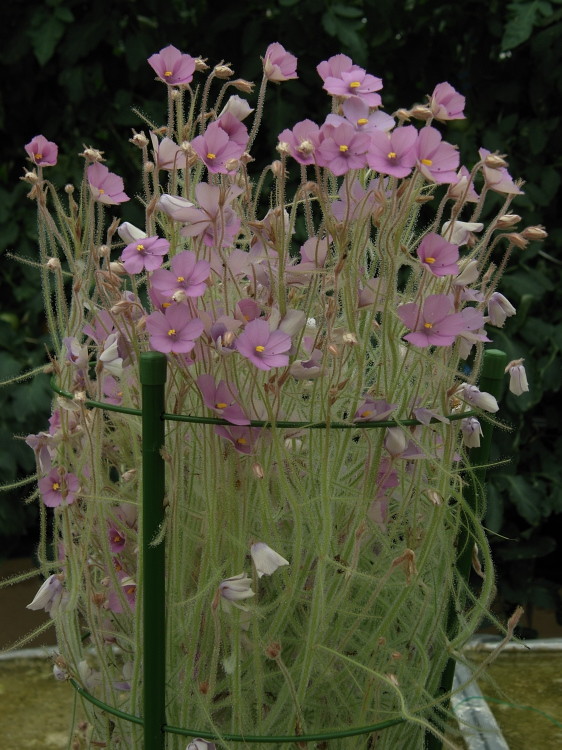 photo 5 |
|
|
|
Post by jonmoyjunk on Sept 6, 2010 11:18:52 GMT
Hello from Geneva! I'm an amateur grower, but had the pleasure of growing both Goliath and Guehoi this year. I raised them in exactly the same conditions (pots were sitting side-by-side) and both plants turned out quite differently, as you can see in this picture of their bases...The circles show the first few weeks of growth of each plant... 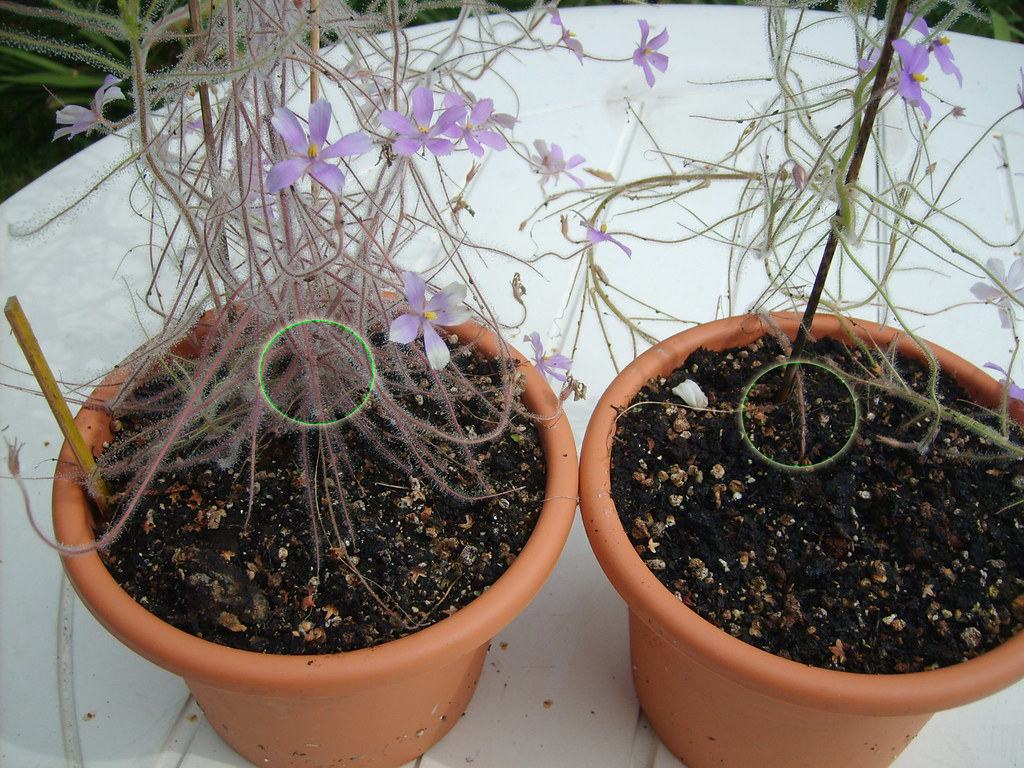 byblis branching byblis branching by westmeetseast.ch, on Flickr |
|
|
|
Post by gregallan on Sept 6, 2010 21:58:58 GMT
Wonderful plants, everyone! Siggi- how many plants are in that pot, and what substrate do you use?
Greg
|
|
sweetpea
Full Member
MOLLIE RILSTONE
Posts: 163
|
Post by sweetpea on Sept 6, 2010 23:09:39 GMT
Dear jonmoyjunk-san, Konnichiwa! Thank you very much! VERY NICE  Dear Greg-san, Konnichiwa! Please see the petal shape of his plant. I guess there was at least one clone in that pot. It is very difficult for me to classify progeny clones of Byblis filifolia ICPS cultivar‘Goliath’ from many other Byblis filifolia forms. Maybe I cannot judge his plant even if I was to see his plant in person at his house. I wrote “progeny clones of Byblis filifolia ICPS cultivar” and never wrote “ Byblis filifolia ICPS cultivar ‘Goliath’”. As you know almost Byblis species are allogamous plants. IN OTHER WORDS Clones will always be slightly different little by little each season from each other in the same location. Kind regards |
|
|
|
Post by shartmeyer on Sept 8, 2010 8:12:44 GMT
Guten Tag "Suesse Erbse" in Japan, Gruetzi to "JonMoySchrott" in Switzerland (I just translated your names to German, I hope you have no problem with that), looking at the photos by jonmoyjunk, comparing what he named "Byblis Kultivar Goliath" and "Byblis guehoi" I see the same plant, but one healthy and one sick. So that example is certainly not applicable to match any difference of any species. The right plant shows what we call "slim disease", while the left plant is looking healthy. I wrote about that problem with Byblis in culture on our website, here is the text including pictures: "Some Byblis in cultivation suffer what we call "slim disease" (2nd photo), probably a fungus infection. The lower stem is suddenly shrinking and reduces strongly. The plant grows only meagerly and will mostly perish within some weeks. Healthy plants with a height of 20-30 cm show a stem with nearly pencil-like diameter (1st photo)." 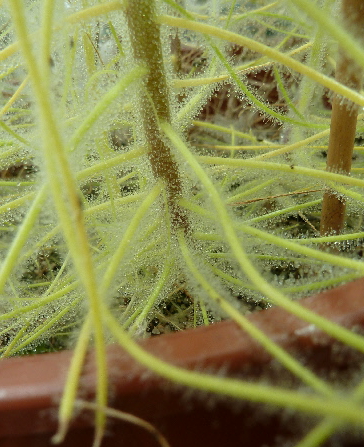 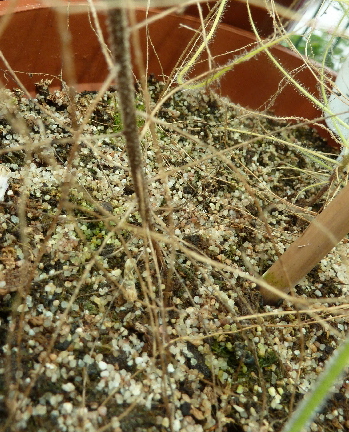 The stem shrinking is normal at the end of the season, when the plants die back, but the plants grow very disturbed when the effect appears in an earlier state, then they grow slower and are less or not at all branching. And that is exactly what jonmoyjunk's pictures and my example above show. |
|
sweetpea
Full Member
MOLLIE RILSTONE
Posts: 163
|
Post by sweetpea on Sept 8, 2010 10:25:03 GMT
Konnichiwa! Thank you very much for your opinion and interesting photos, though those photos are a bit different from my request. Please see: www.cpukforum.com/forum/index.php?showtopic=38315The jonmoyjunk-san's plant looks great and not looks like your 2nd photo. I agree with UtricSeb-san, jimscott-san and Greg Allan-san in the thread. Kind regards |
|
|
|
Post by shartmeyer on Sept 10, 2010 9:53:04 GMT
Hey sweetpea, after more then 20 years experience in growing Byblis I really wonder that you and your friends do not recognize that the right plant of jonmoijunk's photos shows a clearly undersized stem. The plant would without support only hang sadly down beside the pot, and is certainly unable to stand upright like a healthy plant of that size normally does.
My questions to you, and please be honest:
1.) The plants on your photos look healthy and have fleshy stems of about 4-6 mm diameter above the soil (like my healthy plants of that size), isn't it?
2.) The right plant of jonmoijunk has a stem with only about 2 mm diameter, do you really state that such a shrinking is normal and healthy only because it is still flowering?
3.) Do you really state that the difference in stem diameter is not a disturbance of growth but a proof that it is a different species?
|
|
sweetpea
Full Member
MOLLIE RILSTONE
Posts: 163
|
Post by sweetpea on Sept 10, 2010 14:01:23 GMT
Konnichiwa! Unfortunately my experience of almost tropicla Byblis species is since 1999, only 12years now, though I have grown Byblis liniflora for 35years. So I guess I have a poor experience than you. To compare the jonmoyjunk-san's plants with my plants. The figures of jonmoyjunk-san's plants(both species) are far closer ones in the wild. So I believe the jonmoyjunk-san's plant is healthy. Leaves' lack and thin stem do not necessarily mean the sickness. I am trying so that I will reproduce the situation of tropicla Byblis habitats 40000 years ago. I can only imagine it. Attention: I do not intend to criticize Aborigine people. Before Aborigine people had done field burning (artificial bush fire, forest fire) for hunting, the tropical Byblis species habitats were far better condition than now. The situation of present habitats is very severe. I will greatly appreciate your photos(comparative) more than your description. BTW, I had speculated another German cp grower(nurseryman: Mr.Thomas Carow) had already stimulated European cp growers. (or maybe nurseryman in The Netherlands, who know Mr.Thomas Carow.) Sometime is the past Dr.Joachim Nerz told me that Mr.Thomas Carow had shown beautiful tropical Byblis at a meeting of the German cp society. This nurseryman visited me in 2002. I guess you visited a far better place at the time. I met you at the foot of Mt.Koshin-zan( Pinguicula ramosa), because I kidnapped Dr.Jan Schlauer and his wife from there openly. I guess you do not remember me.  Kind regards |
|
|
|
Post by radar357 on Sept 11, 2010 0:51:44 GMT
Awesome pics! Byblis is such a rewarding plant to work with, thanks.
|
|
|
|
Post by jonmoyjunk on Sept 13, 2010 13:37:01 GMT
Hi Herr Siggi (and of course Isao-San),
I'm not an expert, but the "Goliath" came from seeds clearly labelled as Goliath, and the Guehoi came from a package of seeds clearly labelled as Guehoi. Although I only have one plant of each, I think the plants were identified correctly. Both plants were grown in the exact same conditions, side-by-side and if it were really the same species in both packets of seeds, it would be odd that only the seeds in the goliath caught the disease.
As far as my amateur eyes can tell, the Goliath is quite healthy indeed (now it has 17 open flowers, 24 total) and it is slightly over 30cm tall...I just can't fit it into my terrarium upright, so I curved it around.
Grüessi! (greetings)
Jonathan
|
|
|
|
Post by shartmeyer on Sept 29, 2010 10:56:30 GMT
Guten Tag Suesse Erbse (sweetpea),
the thin stem of the large tropical Byblis species must not be a result of fungus, so far you are right, but without any doubt the plant on jonmoyjunk's picture is despite it is flowering meager and apart from healthy upright growth, which you can see with the compared plant. As an experienced grower you know that even under the same conditions you will find stronger and weaker plants from the same seeds. Therefore it is not very professional to state that this difference comes from separate species, especially if only one plant (!) matured from the seeds. I think you are experienced enough to compare the flowers and the seeds for that reason and I wonder why you do not mention this clear visible detail. The tiny brown brush-like structure on one anther of the flowers of both plants is a good sign to state that they are the same species and even not a variety.
From my 2010 experiment (my photos on top of this page) with 6-8 mature plants from each seed pack I found that Byblis cultivar Goliath and the plants grown from the CPUK seeds labeled as B. guehoi are the same species (identical flowers with the brush-like brown structure on curved anthers, strong branching without any cutting of tips), but they are obviously different clones. Probably due to any treatment of the parent plants in tissue culture.
While Goliath is easily pollinated and produces lots of seed-pods, the Guehoi are simply infertile despite I tried my best and treated them the same way, not one seed-pod has been produced during the whole season. Also in growth is Goliath more stable than the CPUK Guehoi, from which all plants died back some 4-6 weeks earlier than the fertile Goliath (standing side by side).
Please don't get me wrong, but for me it looks like that plants from the CPUK Guehoi seeds, which look like the original, are wonderful for business, because the growers need to buy new plants for every new season, while the fertile Goliath (which is certainly closer to nature than the probably in-vitro treated infertile clones (F2-Hybrids??)) provides easily sufficient seeds to even share the seed harvest with other CP-enthusiasts, which is not good for business.
Of course I remember well the 2002 ICPS conference in Tokyo, as Prof. Kondo invited and asked me to produce the official conference video, but I don't remember you. Maybe you can identify yourself on this video (showing also the audience in the conference room), so that I can recognize you:
Certainly nobody who participated in the excursion to Mount Koshin for P. ramosa will ever forget the day. To know what I mean please see the trip, filmed for the conference by Dr. Chiaki Shibata (Nippon Dental University):
Last but not least Gruessli to Jonathan in Switzerland.
Once again thanks for sharing your photos, don't get me wrong, I do not mean that you are a bad grower or did any manipulations, but as a CP-newby (as you call yourself) you will learn sometimes, that also a clear labeling of seed packs is no guarantee to have what you think, and that it is very encouraged to speak about different species if you are dealing with seeds from in-vitro treated plants, especially if you have only two mature plants to compare and even more important if you compare a healthy growing and a meager plant. With a little more experience in Byblis you will learn soon, that both growth-forms may appear from the same batch of seeds, some are stronger, others are meager, even under the same conditions.
|
|
sweetpea
Full Member
MOLLIE RILSTONE
Posts: 163
|
Post by sweetpea on Sept 29, 2010 14:33:48 GMT
Konnichiwa! The tiny brown brush-like structure on one anther of the flowers of both plants is a good sign to state that they are the same species and even not a variety. I disagree that Byblis guehoi and Byblis filifolia ICPS cultivar"Goliath" should be combined due to the feature that you described. Kind regards |
|
sweetpea
Full Member
MOLLIE RILSTONE
Posts: 163
|
Post by sweetpea on Sept 30, 2010 12:42:08 GMT
Konnichiwa! I'm not sure I understood the feature you describe. You wrote:"The tiny brown brush-like structure on one anther of the flowers..." In my cultivation, The tiny purple(or deep mauve etc) brush-like(?) structure on two(rarely three) anthers of the flowers... Some Byblis species have the feature. Some Byblis species do not have the feature. Also a very important fact, I have both variations of Byblis liniflora that have the feature and do not have the feature. Do you divide these Byblis liniflora variations into two species? Or do you insist some variations of Byblis liniflora and Byblis filifolia ICPS "Goliath" are the same species? Even if you insist on either, it seems this conversation is a waste of time. Considering your approach to taxonomy, Taxa should not be defined or combined due to the feature you described. Also I do not think that your purpose is Taxonomy. Again, From my experience, both species of jonmoyjunk-san's plants expressed the differences very well. BTW, Shibata-sensei has been my teacher, a good friend of mine and my colleague for 36years. In March this year, I noticed that you up-loaded her video on youtube. (in Shibata-sensei has been very very surprised about it. Neither Dr.Kondo nor you informed her that you upload her video on youtube. Neither Shibata-sensei nor I are familiar with copyright rule of youtube. Also we are not familiar with copyright rule in Germany. Of course Shibata-sensei is very generous. Kind regards ----- Please see: icps.proboards.com/index.cgi?board=byblis&action=display&thread=4953&page=1 and page2  |
|
|
|
Post by gregallan on Oct 1, 2010 14:21:16 GMT
Hi all, I do not wish to become embroiled in any debate about taxonomy, a subject of which I only have a passing knowledge. I would, however, like to comment on the fertility of Byblis guehoi plants grown from seed obtained from CPUK. In spring 2009, I obtained some seed labeled 'Byblis guehoi, Kimberley' from CPUK. I raised a few plants from these seeds. A couple of them are depicted in this thread: icps.proboards.com/index.cgi?board=byblis&action=display&thread=3193. I cross-fertilised these plants, causing them to produce a lot of seed. The plants were definately fertile. I donated several hundred seeds back to CPUK in early 2010K. This may well be the source of Siggi's seeds. Sold some of the seeds via the CPUK forum, and I retained some of the seeds for myself, sowing them in April 2010. These seeds produced several plants which I once again cross-fertilised. I have, over the last few weeks obtained a substantial number of seeds from these plants. Thus, I can guarantee that any of the CPUK's seeds labeled as B guehoi that came from me will produce fertile plants. I have to say that, unless clipped, my B guehoi plants do not branch, although neither do plants that I have grown from B 'Goliath' seeds obtained from Brian Barnes. Perhaps this has something to do with my growing conditions, which are not ideal. I am, in fact, growing these two varieties side by side, and I must say that they do look very similar, although the shape of the petals is a little different. I have not had the time to attempt to hybridise them, although I understand that some have attempted crosses of B filifolia and B guehoi without success. See this thread: www.cpukforum.com/forum/index.php?showtopic=36376 towards the end, after all of the controversy) for details. Greg |
|







